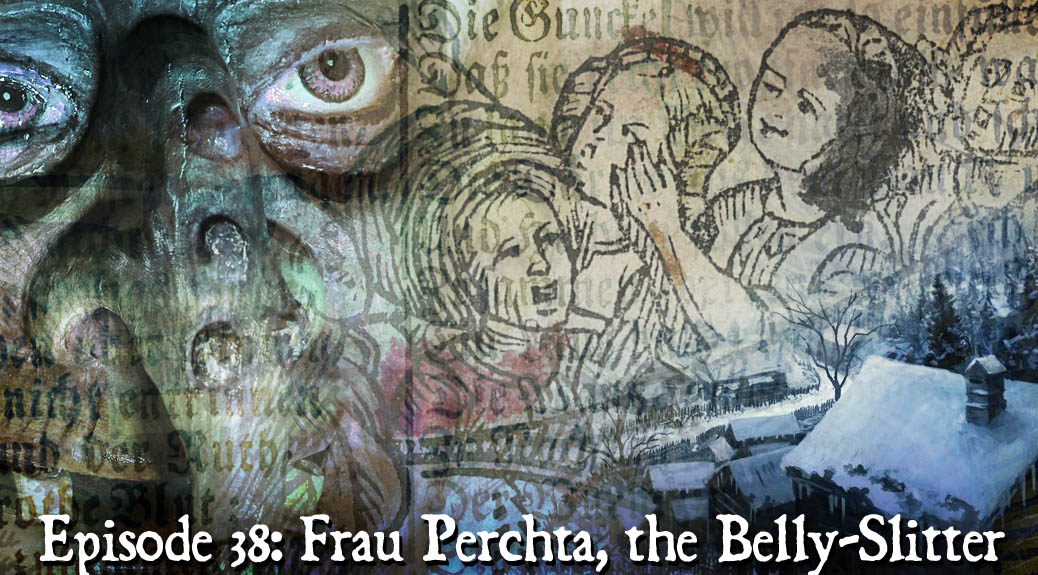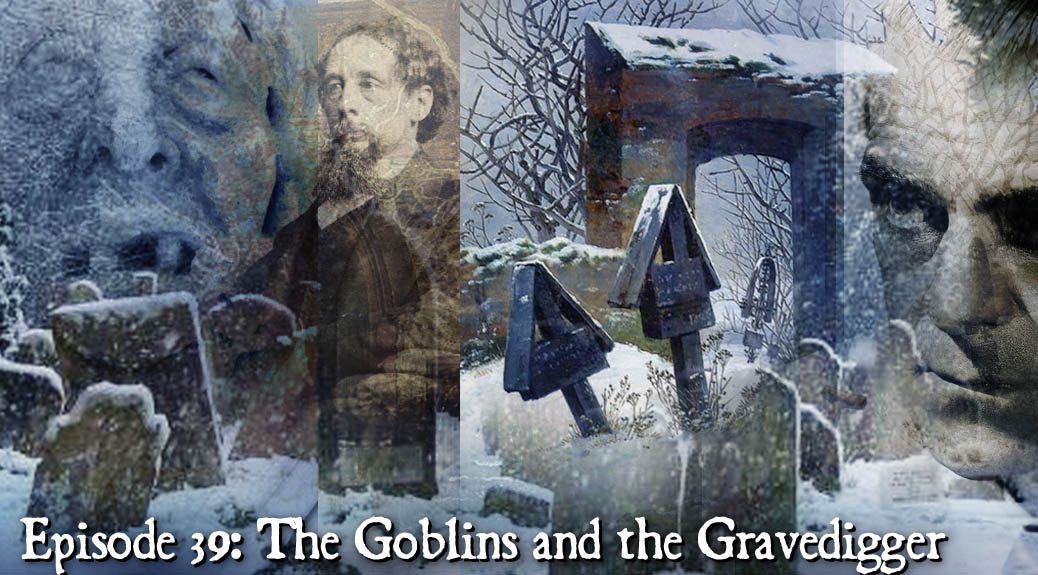
The Goblins and the Gravedigger
Podcast: Play in new window | Download (Duration: 29:06 — 26.6MB)
Subscribe: Apple Podcasts | Spotify | Android | Podchaser | RSS | More
Bone and Sickle continues its holiday tradition of Christmas ghost stories, or a goblin story, in this case. Our tale about an encounter between a gravedigger, or sexton, and a host of goblins is extracted from Charles Dickens’ 1843 novella, The Pickwick Papers. Strangely, it is not Dickens’ only Christmas goblin story.
As a special holiday treat, our reader for the story beloved personality well known to all Bone and Sickle listeners.

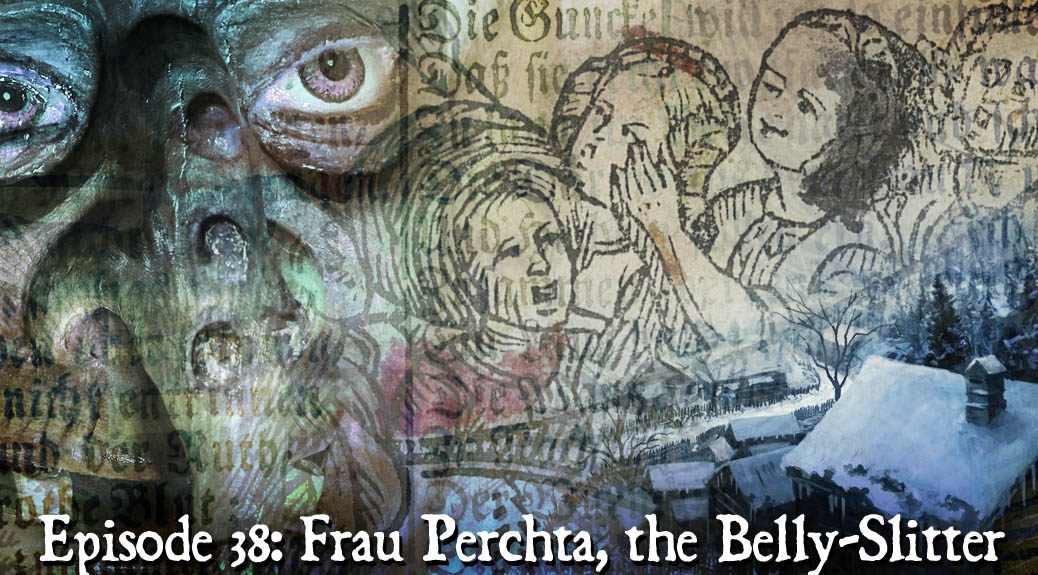
Frau Perchta, the Belly-Slitter
Podcast: Play in new window | Download (Duration: 42:18 — 38.7MB)
Subscribe: Apple Podcasts | Spotify | Android | Podchaser | RSS | More
Frau Perchta, sometimes known as “the Belly-Slitter” for the trademark punishment she’s said to inflict on disobedient or lazy children, is figure of Alpine folklore of Austria and Germany in many ways similar to the Krampus.
“Perchta” is only one spelling or name for this figure, who may also go by Pehrta, Berchte, Berta, and a myriad of other names. A particularly good representation of the figure, a woodcut from 1750, identifies her as the “Butzen-Bercht,” with the word “Butzen” coming from a word for “bogeyman.” This word also appears in a classic 19th-century German children’s song and game “Es Tanzt Ein Bi-Ba Butzemann,” or “A Bogeyman is Dancing,” from which we hear a clip at the show’s start.
The woodcut in question depicts a crone-like character with dripping, warty nose, who is carrying on her back a basket filled with screaming children, all girls. She stands before the open door of a house where more girls are screaming, and is holding a dangerous looking pronged staff as well as a distaff, the stick used to hold fibers that will be spun into wool or flax on a spinning wheel. The importance of the illustration is the way it emphasizes Perchta’s connection to spinning and to the females of the household responsible for this task. The woodcut also features some text delightfully detailing a series of horrid threats delivered by Perchta, dramatically read by Mrs. Karswell.
Perchta’s name it comes from her association with Epiphany or Twelfth Night, January 6, the last of the “Twelve Days” or nights of Christmas, the “Haunted Season,” we discussed last year in our episode of that name. “Perchta” is a corruption of the word giberahta in the Old High German term for Epiphany, “giberahta naht,” meaning, the “night of shining forth or manifestation.
Now there’s another name many of you will have encountered if you’re read up on Perchta: Perchten, figures very similar to the Krampus. (Perchten is plural. The singular is Percht.)
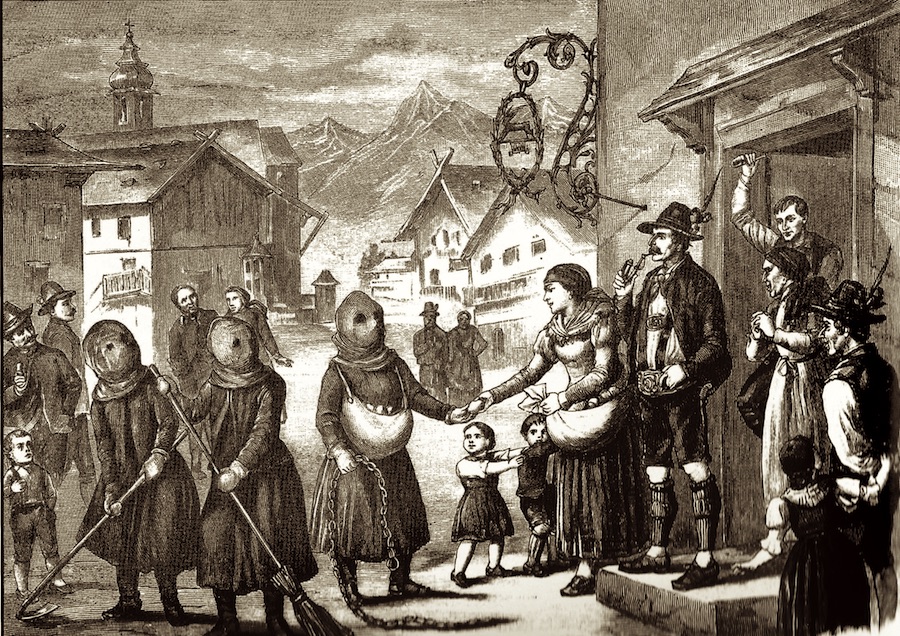
While the first mention of Perchta appears around 1200, the word “Perchten” is not employed until centuries later. In 1468, there appears a reference to her retinue, but its members are not called Perchten, nor do they explicitly resemble Perchten as we think of them today. At this stage in Perchta’s mythology, the company she leads is most often understood as spirits of the departed. With time, and frequent attacks from the pulpit, Perchta’s pagan company came to be commonly feared not as ghosts but as demons, something presumably closer to the horned figures we now know. By the 15th century, a tradition involving costumed processions or appearances of these figures had evolved. The very first illustration we have of Perchta seems to show not the figure herself, but in fact a masker impersonating “Percht with the iron nose.” It appears in South Tyrolean poet Hans Vintler’s 1411 Die Pluemen der Tugent (“The Flowers of Virtue”).
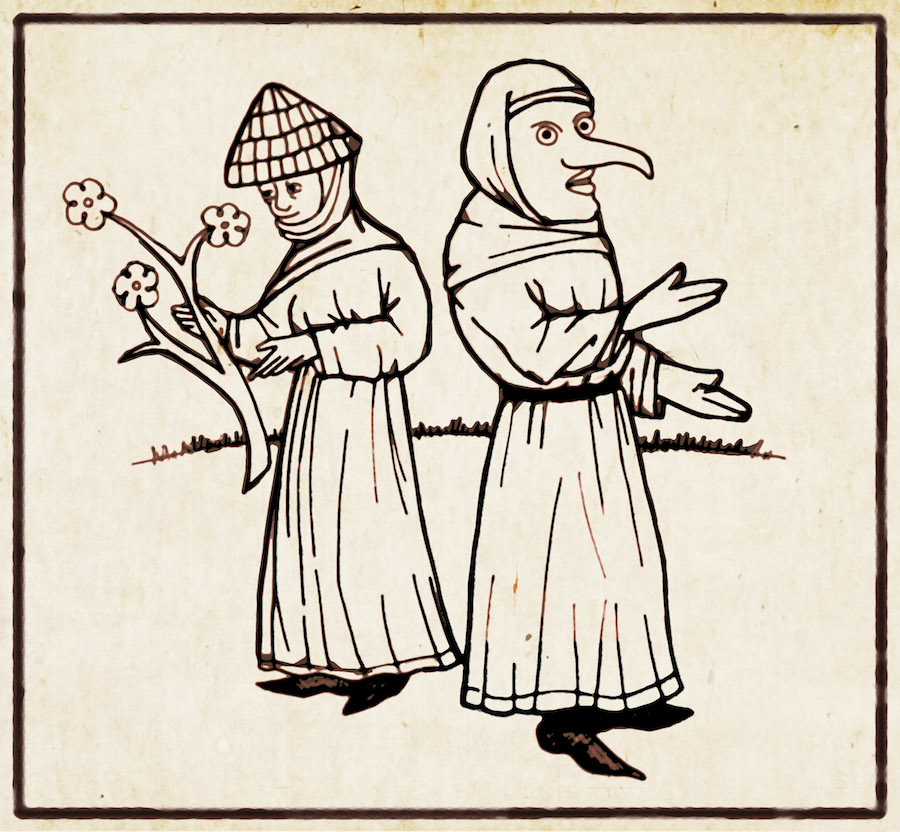
This beaklike nose of Perchta may be related the figure’s ancient connection to the classical strix (plural striges) which appears in both Greek and Latin texts. The strix is bird of ill omen, often thought of as an owl, one that visited at humans at night to feed on blood and flesh. Bird-like representations of Perchta or the Perchten appear in the Schnabelperchten (“beaked Perchten“) figures that appear in the town of Rauris, Austria.
In addtion to Perchta threatening to cut open the bellies of the disobedient, she’s sometimes said to stamp on those who offend her. In certain regions, it is the Stempe, or the Trempe (from the German words for “stamp” or “trample”) who appears to frighten the disobedient on Twelfth Night. A medieval poem, alluding to the terrible Stempe, one quoted in Grimm’s Deutsche Mythologie, is read by Mrs. Karswell.
One way to avoid Perctha’s wrath was to prepare certain foods, particularly a porridge called Perchtenmilch, which would be partially consumed by the family on Twelfth Night with a portion set aside as an offering to the Perchten. Certain signs, that the porridge had been enjoyed by the night-traveling spirits could provide omens for the coming year. Mrs. Karswell reads an Austrian account from 1900 detailing these.
This custom of leaving out offerings on this night was frequently condemned by the clergy in Austria and Germany, and we hear similar practice involving the Swiss “Blessed Ones” (sälïgen Lütt) derided in an 17th-century account by Renward Cysat, a city clerk of Lucerne.
The dead who accompany Perchta and consume these offerings are in many tales called the Heimchen, the spirits of children who have not received baptism. Several tales of Perchta and her Heimchen from Jacob Grimm’s Deutsche Mythologie are recounted.
Our episode concludes examining a peculiar connection between Perchta and the beloved English and American figure of Mother Goose.
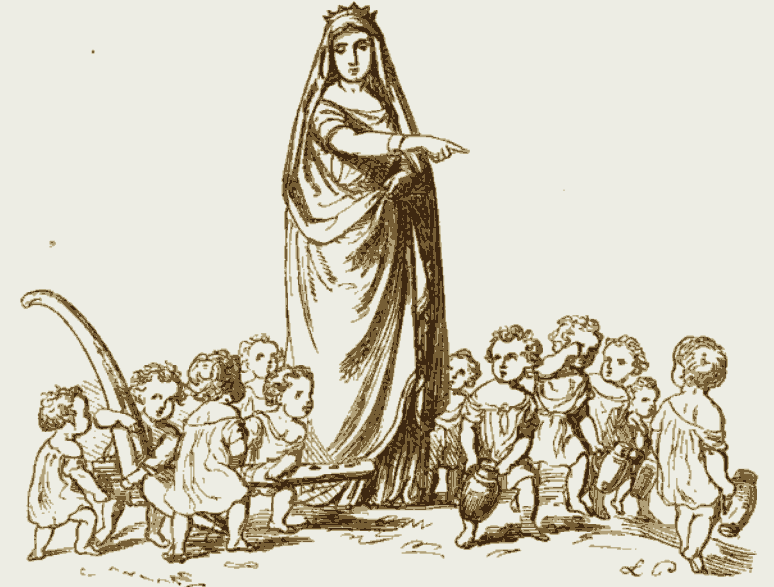
(Material in this episode taken from my book, The Krampus and the Old, Dark Christmas.)
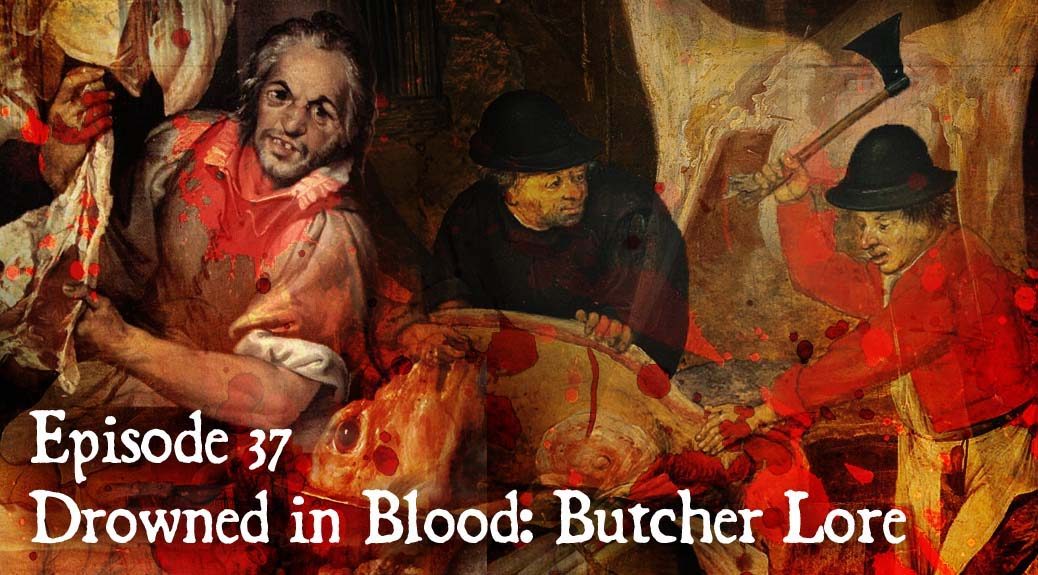
Drowned in Blood: Butcher Lore
Podcast: Play in new window | Download (Duration: 43:44 — 40.0MB)
Subscribe: Apple Podcasts | Spotify | Android | Podchaser | RSS | More
Our seasonal look at butcher lore begins with the slaughter of an immense ram as related in the centuries-old English song, “The Derby Ram” (AKA “The Darby Ram”). In the lyric, a butcher and his boy assistant are “washed away in the blood,” giving us our episode’s title. The song is roughly enacted in an old Christmas folk play from Derbyshire, “Old Tup” (an old local word for “ram.”) We hear a montage of snippets of the song from The Kossoy Sisters, John Kirkpatrick, John Roberts, and Matt Williams.
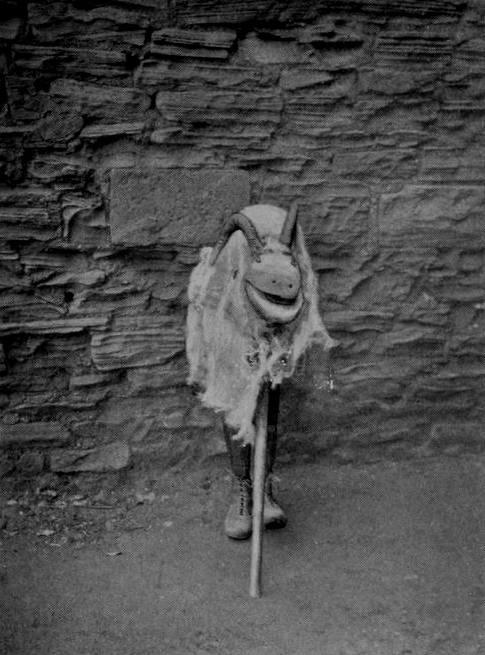
While the 19th-century trend among folklorist to view mummer’s plays like this as vestiges of ancient pagan rites is no longer accepted, the notion does suggest our next topic: a Germanic emphasis on sacrifice during the month of November, which the Anglo-Saxons called Blod-monath (“month of sacrifice.”) We look at the Scandinavian yuleblót marking the beginning of Winter and its connection to Freyr and his sister Freyja, both symbolized by boars or swine sacrificed in this rite. Along the way, we hear Mrs. Karswell read a famous 11th-century account by the chronicler Adam of Bremen describing particularly spectacular sacrifices said to be offered in the ancient temple that once stood outside Uppsala, Sweden. We also touch upon the Anglo Saxon Modranicht or “Night of the Mothers,” which was celebrated on Christmas Eve.
Next we discuss the slaughter of swine, November’s traditional “Labor of the Month”among medieval peasantry. Its aristocratic equivalent is the boar hunt carried out in November and December. We have a look at the serving of boar’s head at Christmas among the nobility and hear a snippet of the medieval Boar’s Head Carol as well as a whimsical tale told at Oxford supposedly explaining how the boar’s head custom arrived at Queen’s College.
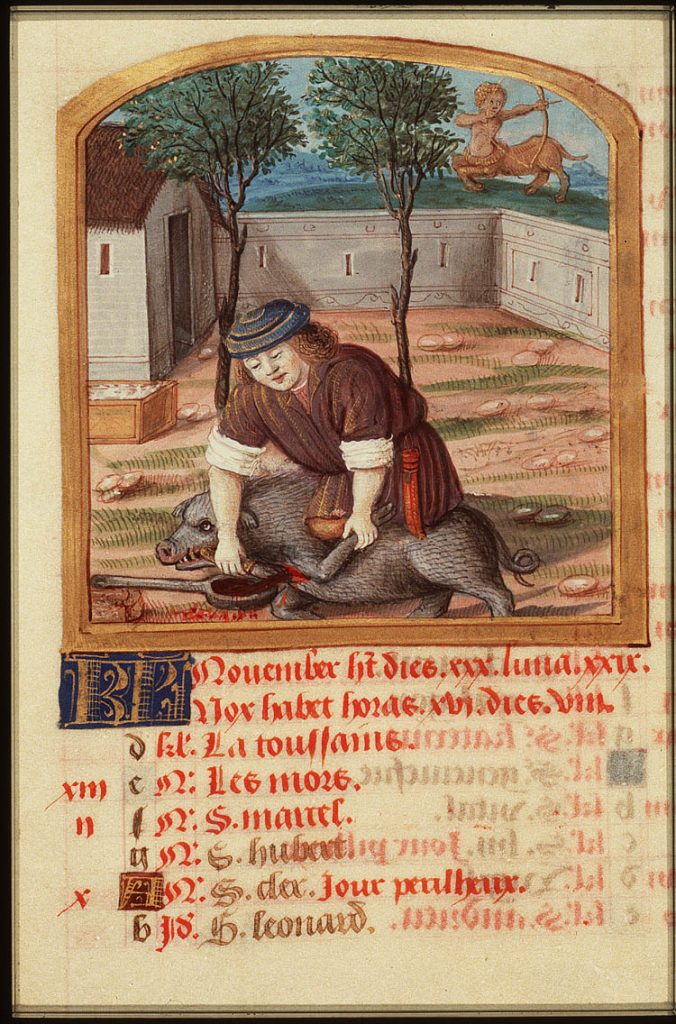
The particular day most traditionally associated with the slaughtering of animals for the Winter (and the old day regarded as the beginning of winter) is November 11, St. Martin’s Day. We hear of a strange St Martin’s custom associated with the slaughter of beef in Stamford, Lincolnshire in the 17th-century and of the magical use of blood from fowl slaughtered on this day in Sweden and Ireland. Our “meaty” segment ends with a bit of the comic song “A Nice Piece of Irish Pig’s Head.”
A tradition in Lower Bavaria fixes December 21, St. Thomas Day, as the date for dispatching swine and is associated with the appearance a demon or ogre by the name of “Bloody Thomas.” We hear a description of a cruel and/or amusing 19th-century prank played on children on this day.
Next we look at the legend of “St. Nicholas and the Three Schoolboys,” which has an unsettling connection to our gory theme. A clip from a French song from the 16th century ‘”La légende de Saint Nicolas“” is included as is a story of the Alsatian bogeyman, Père Fouettard, an equivalent of the Krampus or Knecht Ruprecht said to be related to this particular Nicholas legend.
From 14th century Scotland, comes the story of butcher from the town of Perth who famously turned to cannibalism. Born Andrew Christie, he is better known as “Christie Cleek,” from an old Scottish word for “hook,” an implement important in his grisly deeds.
We close the show with a look at Sawney Bean, Scottish leader of a incestuous cannibal clan believed to be a legendary reworking of the more historically based tale of Christie Cleek.
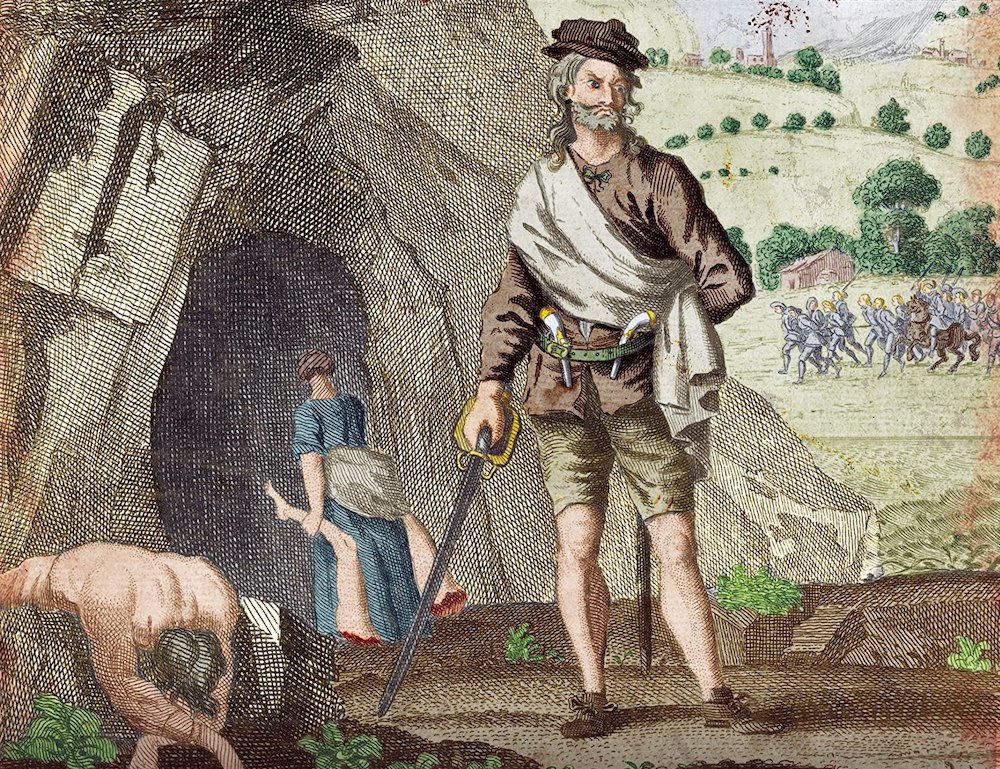
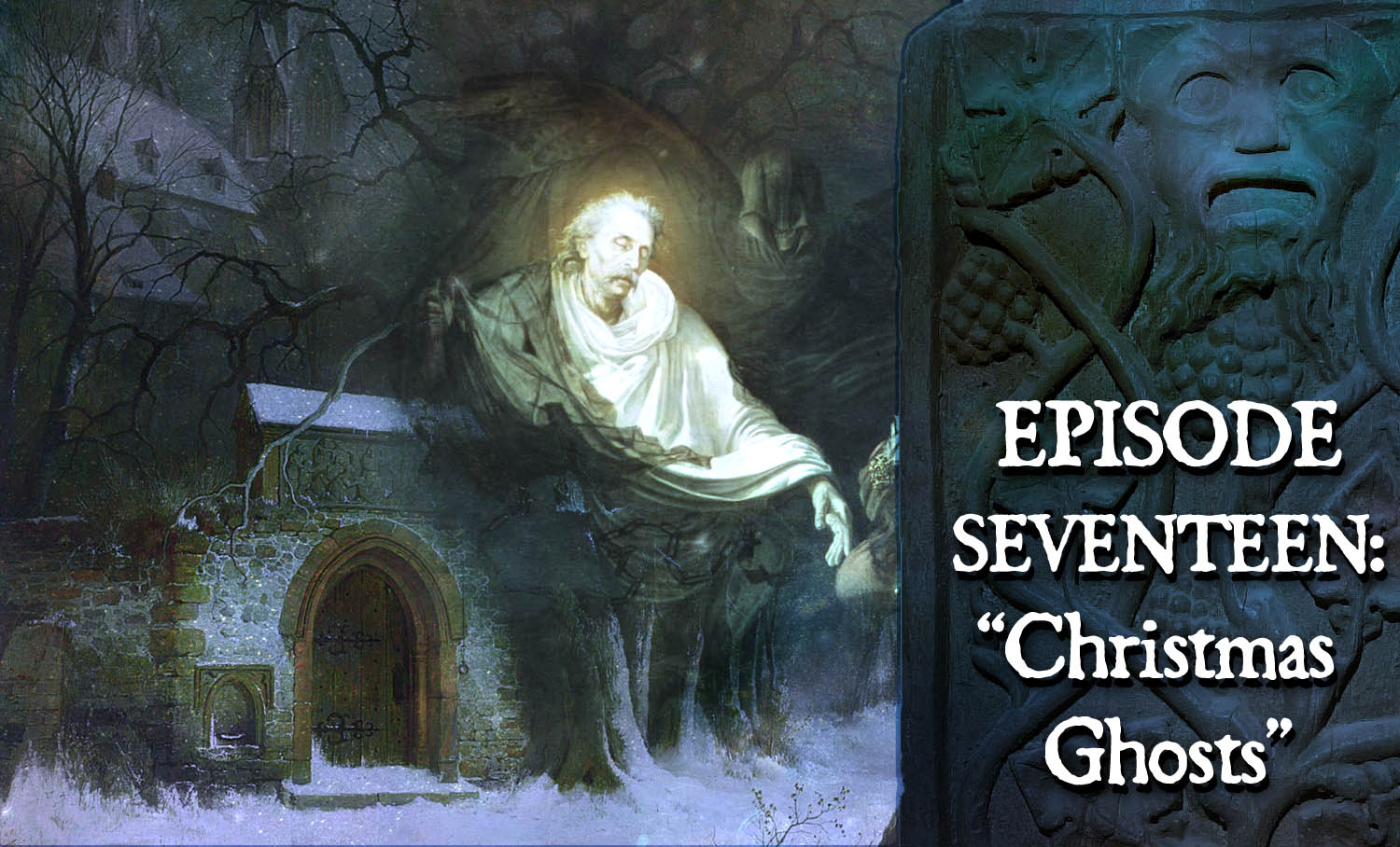
#17 Christmas Ghosts
Podcast: Play in new window | Download (Duration: 39:12 — 35.9MB)
Subscribe: Apple Podcasts | Spotify | Android | Podchaser | RSS | More
Traditionally Christmas was a time for ghost stories, and tonight we’re doing our part to bring back the custom. A bit of history on supernatural stories of the season and then something a bit different for the holiday — a bit of storytelling for your fireside enjoyment — a ghost story from the Victorian master of the genre, M.R. James. An unfortunate holiday incident experienced by Wilkinson and your narrator is also discussed. Merry Christmas to you all! (This episode also provides an example of one of our Patreon rewards: audio texts from classic old books of horror and folklore delivered over a brooding soundscape.)
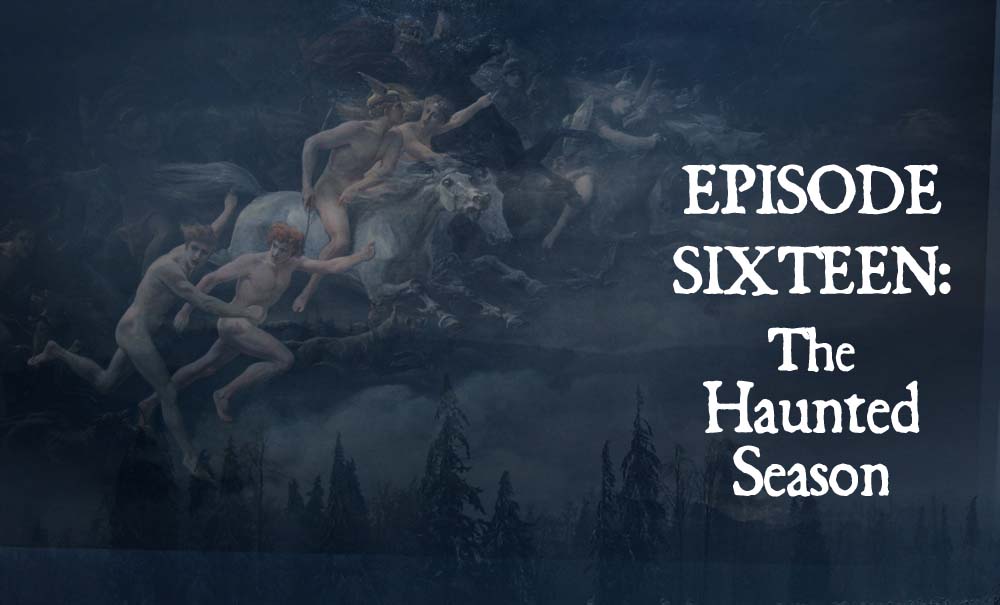
#16 The Haunted Season
Podcast: Play in new window | Download (Duration: 37:27 — 51.4MB)
Subscribe: Apple Podcasts | Spotify | Android | Podchaser | RSS | More
Historically, Christmastime in Central Europe was a season haunted by otherworldly spirits, werewolves, ghostly huntsmen, and wandering hordes of lost souls. This is particularly the case in the Krampus’ homeland of German-speaking Central Europe.
We open with a survey of the various frightful spirits said to be afoot this time of year. Bavaria, particularly the Bavarian Forest turn out to be particularly rich in such things, menaced by everything from spirits of the forests (Schratzn) and marshes to entities said to reside in mills, and historic castles. Historical figures with unsavory reputations including the legendary cowherd Woidhaus-Mich, Chatelaine Maria Freiin of Castle Rammelsberg and the Bavarian outsider prophet Mühlhiasl of Apoig are said to return as evil spirits this time of year. We hear a brief clip from Werner Herzog’s 1976 production, Heart of Glass, a lovely and peculiar treatment of Mühlhiasl’s story.
Just as the Krampus appears as an evil counterpart to St. Nicholas on his feast day (and its eve), we encounter other frightful creatures from German culture said to represent similarly sinister incarnations of other saints celebrated in December. From the Upper Allgäu region of the Bavarian Alps, there are the moss-encrusted Bärbele (“Barbaras”), or sometimes “Wild Barbaras,” and throughout Bavaria and Austria, St. Lucy was also inverted on her day (Dec. 13) as the “Luz,” or “ugly Lucy,” an entity particularly hungry for blood and ghastly punishments. We also meet “Bloody Thomas,” a figure appearing on the eve or night of St. Thomas Day, December 21.
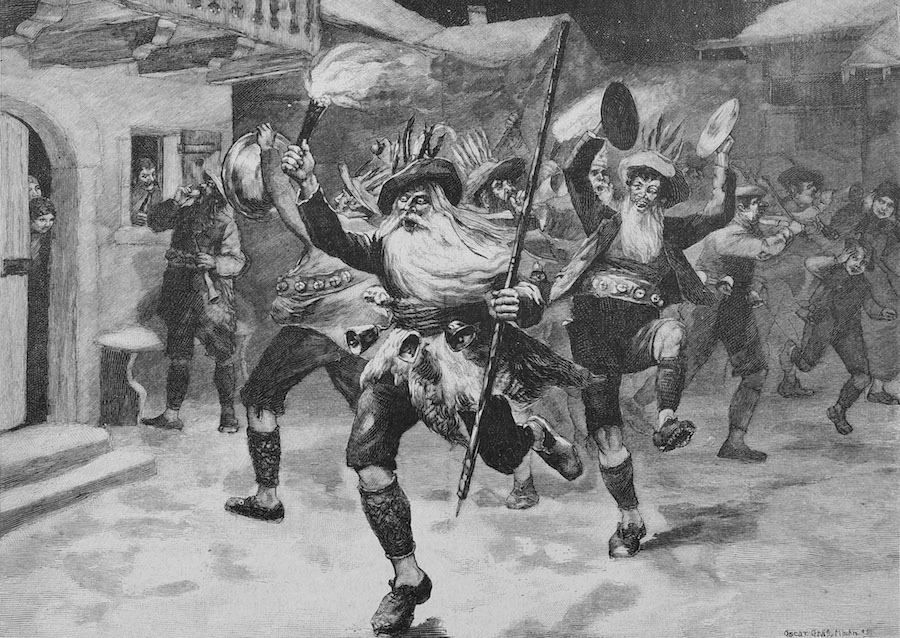
Next we consider a raft of superstitions associated with the Twelve Nights, or Rauhnächte, a name likely derived from the German word for “smoke” (Rauch) thanks to the use of incense during these nights to dispel evil influences.
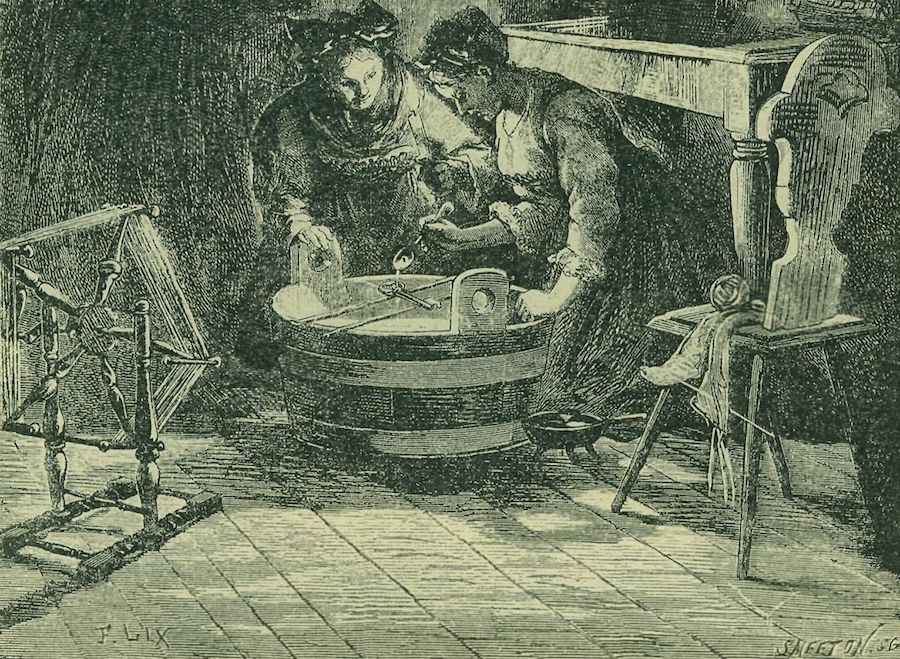
Of all the terrors unleashed during the nights around Christmas, the most widespread in German-speaking lands were those ghostly hordes in nocturnal processions, dead souls, solemnly walking, or wildly riding, the latter usually going under the name of “Wild Hunt” or “Furious Army.” This mythologem is prevalent throughout Central Europe, Scandinavia, the British Isles, and even North America, where the spirits appear in cowboy legends, and made their way into the 1940s country-western ballad “(Ghost) Riders in the Sky.”
Wilkinson reads for us some rather dramatic (and grisly) accounts of this form of apparition from the 16th century, and we hear a variety of accounts emphasizing the weird sounds that were said to accompany the Wild Hunt.
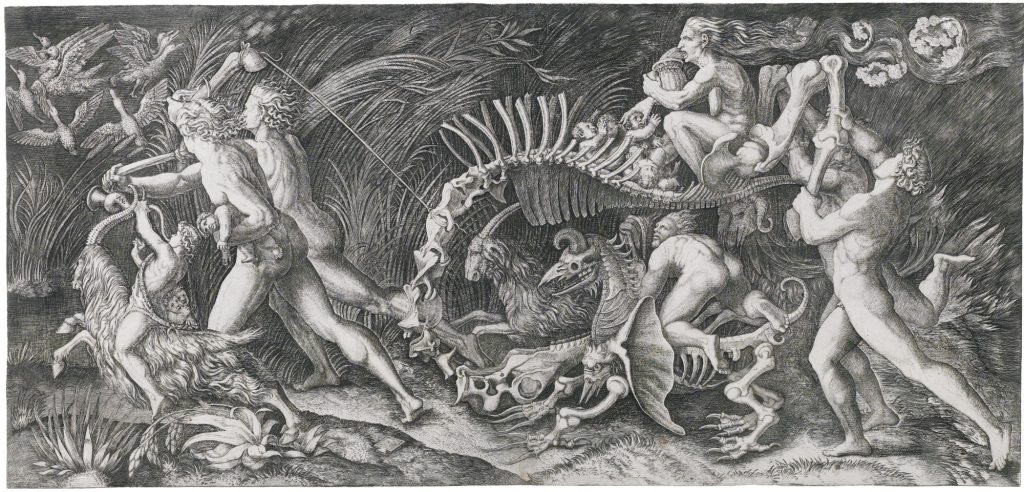
A number of figures were presented as the leader of the Wild Hunt, in particular the Germanic god, Odin, whose presence was associated with the superstition all the way into the 1800s as we hear from a newspaper account of the period.
We close the show with some folk tales recounting a similar phenomena in Austria and Switzerland, namely tales of the “Night Folk,” or “Death Folk,” nocturnal hordes whose appearance often heralded death or misfortunes.
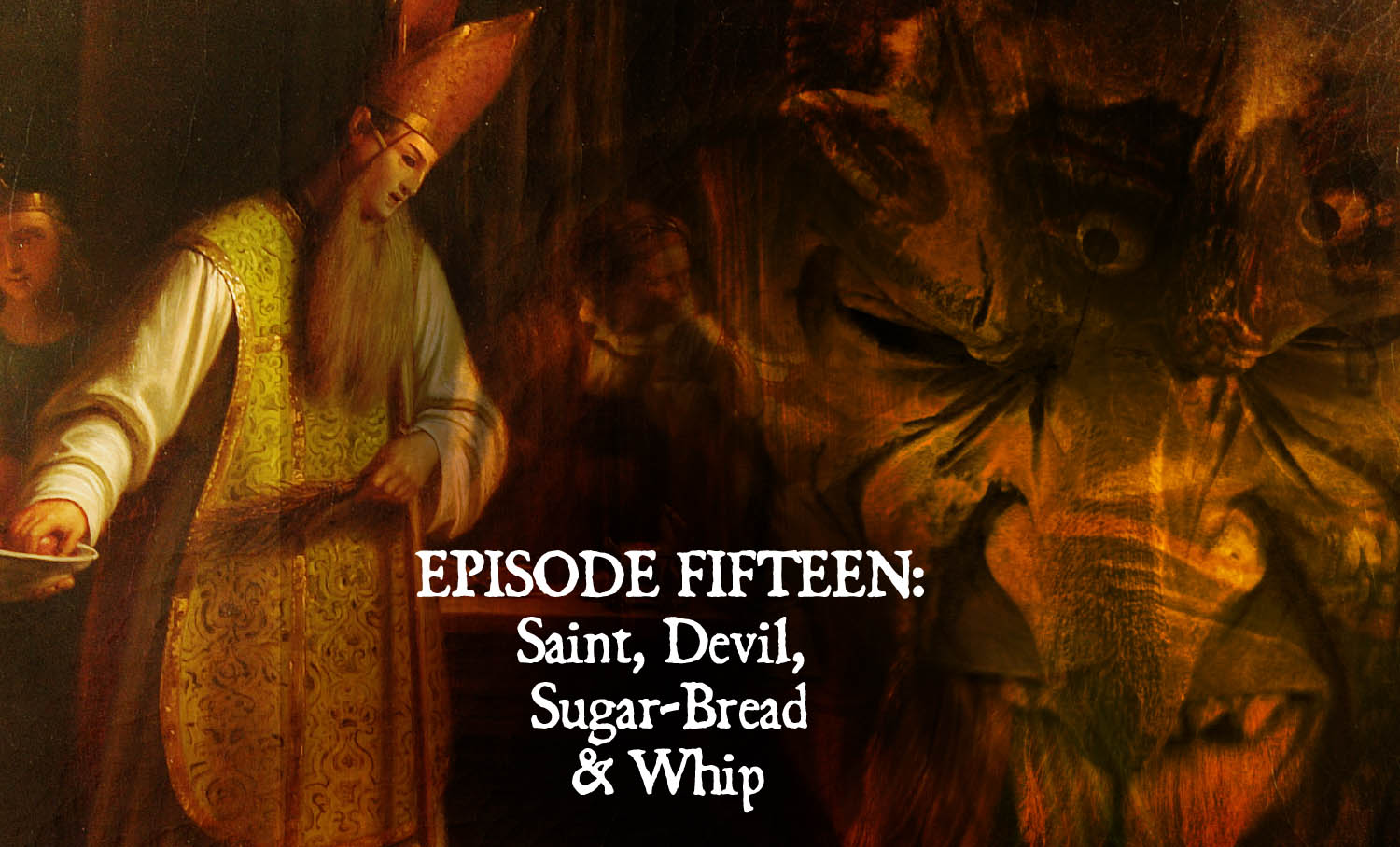
#15 Saint, Devil, Sugar-Bread, & Whip: KRAMPUS AND NICHOLAS
Podcast: Play in new window | Download (Duration: 39:10 — 35.9MB)
Subscribe: Apple Podcasts | Spotify | Android | Podchaser | RSS | More
The Krampus and St. Nicholas represent a folkloric duality embodying a mode of childrearing the Germans call “sugar-bread and whip” — in English, “carrot and stick.” In this episode, the first of three exploring the darker folklore of the season, we look at the Krampus’ origins in the old custom of Krampus and Nicholas house-visits and the older Alpine “Nicholas Plays.”
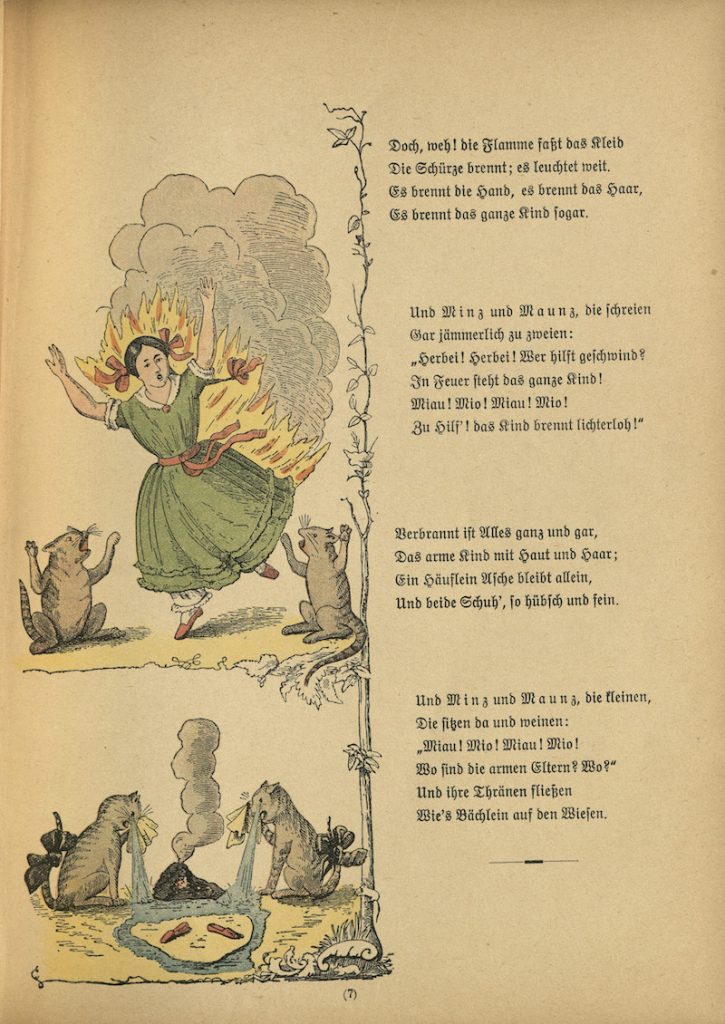
We begin our discussion with a consideration of the “sugar-bread and whip” literary example par excellence, Der Struwwelpeter, the 19th-century German children’s book in which “un-groomed Peter,” and other misbehaving children meet dreadful ends. An clip from a 1955 cinematic version of the story from Germany, and a bit of The Tiger Lillies’ “junk opera,” Shockheaded Peter is included.
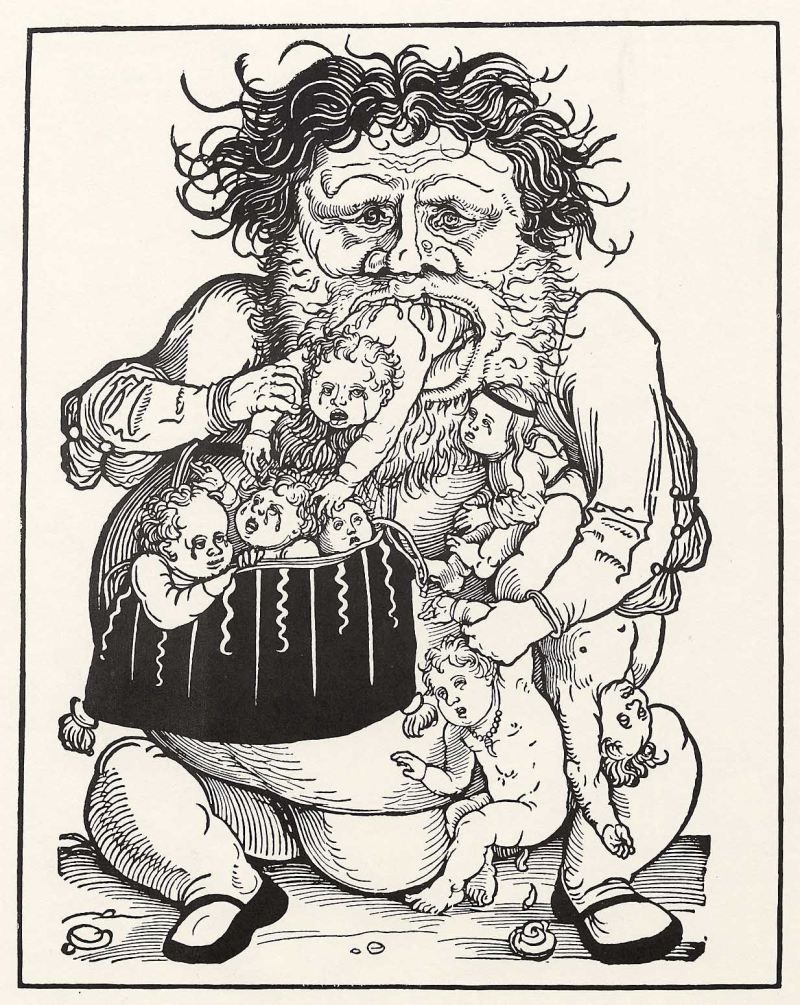
As the Krampus is, at root, simply a bogeyman, we discuss some early (and ghastly) images of German bogeymen from Carnival broadsides, which might be considered forerunners of the Krampus. The “Child-Eater Fountain” in Bern, Switzerland, a sculptural rendering of these same figures, is also mentioned.
A soliloquy delivered by a rhyming Krampus in an old 19th-century Alpine “Nicholas play,” introduces us to the figure. The verse is a translation from your host’s book The Krampus and The Old, Dark Christmas, as is much of the material in this episode.
Next we discuss the source of the Krampuslauf (Krampus run) tradition in the old custom of house-visits made by costumed troupes consisting of a St. Nicholas, Krampuses, angel assistants to the saint, and an odd backwoodsy character called Körbelträger (basket carrier). Part of the visit discussed is small test of the children’s good character consisting of a performance for St. Nicholas of a memorized poem or song. A traditional song for this occasion is “Lasst uns froh und munter sein,” which we hear in a clip. We also hear some background sound effects provided by an excellent video depicting traditional Krampus customs in Austria’s Gastein Valley.
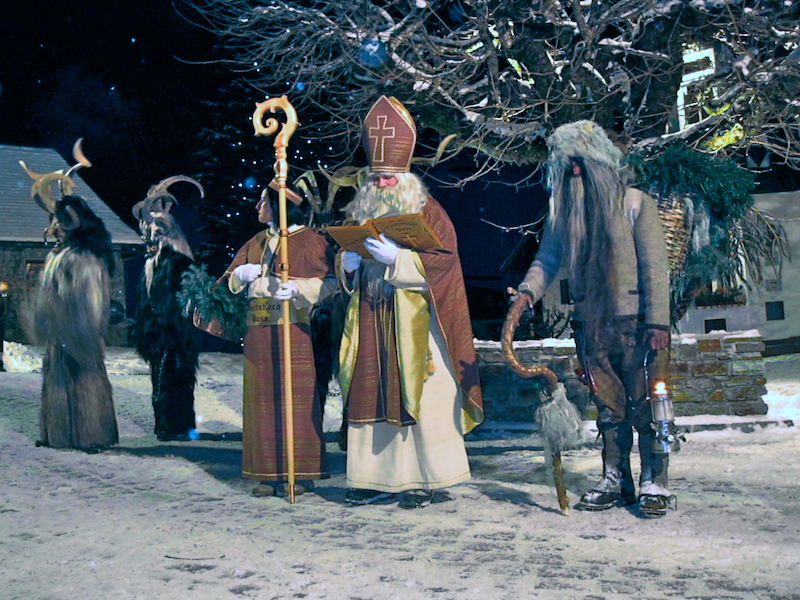
We then have a look at ways in which the tradition of Nicholas plays featuring the saint mingled with local pagan folklore of the Perchten, winter spirits of the German-speaking Alps, and hear a number of historic accounts illustrating how this rowdy element worked its ways into the Nicholas customs of centuries gone by. Various outrageous are documented from drunken Nicholases to actual deaths of performers.
The show concludes with a more in-depth look at these Nicholas plays, including some bawdy slapsticks elements hardly befitting a saint. Wilkinson delivers a stirring rendition of the “Lucifer Sermon,” a devilish rant, traditionally concluding these plays.
LISTENER NOTE: During our intro segment, we also receive a phone message from Mark Norman of The Folklore Podcast responding to the ongoing dilemma of the phantom cat, which seems to be haunting the Bone and Sickle studio-library. (Listeners who have not yet tuned in to the Folklore Podcast, should also watch for Mr. Ridenour upcoming appearance on the show, in which he discusses some pagan aspects of the Krampus myth not covered elsewhere.)

